

|
Home Updates Hydros Cars Engines Contacts Links Contact On The Wire ←Previous |
Edgar Westbury (con't)
In 1940, Westbury made the decision that the MPBA would cease all activities for the duration of the war, although many clubs and individuals continued to run and attend regattas. However, he continued to publish regular articles and engage in extensive correspondence on hydroplane hull and engine design throughout the war.
|
In April 1942, he dug out Golly again to exhibit at the Sutton Club exhibition, which was held in conjunction with Warship Week, an event that would have been particularly relevant to him. Alongside all that, he was working for the Ministry of Supply on what was believed to be lightweight generating sets as well as travelling around the Country lecturing to various groups, organisations and societies. Even at the height of the war in December 1942, Westbury presented two lectures to the Glasgow Society of Model Engineers, quite a trek. |
|
Amidst all this, first the Blitz, and later the V1 and V2 attacks necessitated numerous moves for the Westbury family, but probably the most significant event was the Blitz, during which the offices of Percival Marshall in Kingsway were destroyed. Much of Westbury’s technical material, photographs, drawings and MPBA material, including several trophies, were destroyed, only what he had at home at the time surviving. This was compounded by another raid in 1941, which destroyed the blockmaking business that Percival Marshall used, with the loss of even more drawings and photographs.
Only if one reads the pages of Model Engineer and is aware of the various guises that Westbury assumed in writing articles, as well as those under his own name, can it be fully appreciated just how much time and effort he must have been spending every week working on these. Beyond the writing there was the research, experiment, development and drawing that went into every project and article, as well as lectures, visits to meetings, regattas, exhibitions and other events. In mid 1939 he published a series of articles detailing the construction of a 24inch long hydroplane, very much along the lines of a smaller Golly, although using a more conventional style of construction with frames, stringers and ply skins. The skeg was again bolted to the stern, which leads us to believe that the similar sized Keil Kraft Zipper might well have been derived from this design. Certainly, the 1066 Products 24 inch hydro that also appeared in the late 1940s also seems to have a ‘Westbury influence’ again being very similar, and it is known that there was a close connection between him and Geoffrey Hastings of 1066. Indeed there is evidence that Mr Hastings might have been a fellow member of the South London Club during the late 1930s.
One important feature of the 1939 articles was that the hull was shown with another of Westbury’s engines fitted, the Kinglet. It has to be said that this was hardly a suitable motor as it was a slow revving, low powered side valve four-stroke and hardly intended for racing. A lightweight two-stroke would have seemed much more appropriate, yet Westbury admitted in 1940 that ‘we have been inclined to neglect the development of really light engines in recent years, in particular that of the high power two-stroke’. He does go on to say that his policy was dictated by popular choice and that his attempts to convince people of the effectiveness of lightweight engines ‘a dismal failure’.
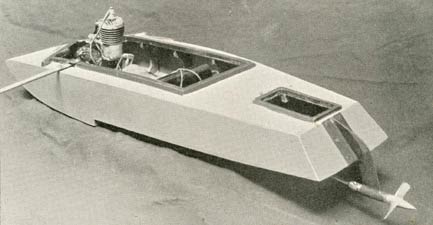 |
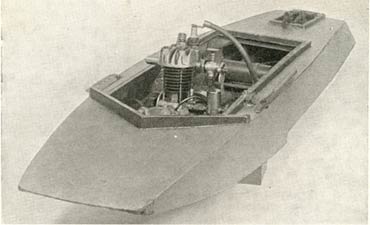 |
| 24" Prototype fitted with American two-stroke | Fitted with Kinglet and showing testing damage to bow |
This brings us to a brief mention of some of Westbury’s designs that were used to great success in hydroplanes by other competitors. The basic Kiwi from 1935 that had started its life in Golly was used for experiment and development through a MkII version, and then with the inclined valve cylinder head that was essentially the prototype for the Kittiwake. There was a 30cc version of this motor called the Kittihawk, which is probably the most impressive of all the designs as it looks just like a miniature version of a racing motorcycle engine.
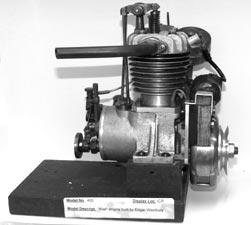 |
|
|
| Kiwi | Atom V | Kittihawk |
The last incarnation of the Atom line was the Atom V, ‘intended principally for model speed-boat propulsion’, whereas the Atom IV was an aircraft unit. The Atom V was built in large numbers, even to this day and also formed the basis of many more home built motors. The basic design principles of the Atom V were incorporated into very much more powerful engines that can still be seen in even the most modern racing engines. What did let it down was the poor cylinder and porting configuration, which brings us to the major contradiction in the engine designs of Edgar Westbury.
|
There is a popular saying that says the initials ETW actually stands for ‘Engines That Work’ and few would argue with this, as those that Westbury found were less than successful never made their way into formal designs or commercial availability. Where his biggest source of criticism came from amongst his contemporaries was that he was seldom prepared to incorporate current or new ideas into his designs, and often persisted with principles that were out of date, or even discredited. Having said that, his articles were constantly featuring engines that did have new, and in many cases, quite radical elements, so he was not opposed to development, but did seem to prefer dependability, reliability and ease of construction for motors that had his name attached to them. Right: Judging with J N Maskelyne, Geo Thomas and Bert Martin |
|
Although he never became involved with running a flash steam hydro, Westbury was a great enthusiast for this type of propulsion, writing an incredibly number of articles on the subject. He also published a book on flash steam that is still available and worked tirelessly to encourage participation and success with the steamers. Through Model Engineer he also arranged the disposal of two of H.H Grove’s early flash steam hydroplanes, both of which by some miracle have survived to the present day and been identified.
Of Westbury’s own boats, nothing save a few sections of engine mountings has survived, but there is a fascinating postscript concerning the original ‘Miss Halton’. When Westbury left the RAF establishment, he bequeathed the old ‘Miss Halton I’ to aircraft apprentice W Protheroe who lived in Chesterfield.
|
|
It then passed to Chesterfield Club member Jack Orme with the bows smashed in and a reputation for nose-diving. Orme rebuilt it with finer lines and higher chine, more like the Cox designed ‘Miss Halton II’ although he did not know it at the time. He fitted it with a commercial 30cc four stroke motor, testing it almost every night during fine weather but never got more than 20mph. Orme then built an Atom III with a later
MK IV carburetter lent to him by a friend, which increased its speed and
reliability so that it would do 30 laps at around 32mph. As an aside, Orme
describes how the boat was run on Walton Dam in 1935, which was 12ft deep so had
to be started and launched from a rowing boat, which was then pulled back
quickly to the bank. |
Hydroplane racing had continued throughout the war at club level, but it was not until 1946 that the MPBA was reformed and official events were run again. At the 1946 AGM, Westbury stated that he wanted to retire from his position as Secretary, yet stayed until 1948 when John Benson succeeded him whilst he became Chairman of the Association. On the death of Ted Vanner in 1955 Westbury became President, a post he held for the next 14 years. Throughout the late 1940s and for the following 10 years or so, Westbury was a regular visitor to regattas and he can often be seen in photos with a 35mm camera around his neck.
|
Amongst all his other interests he was a mad keen photographer, taking technical photos for illustrating articles and lectures as well as the normal range of family pictures. The amazing archive he left starts in the late 1920s with large glass plates, before moving to 6x9cm plates and then onto similar sized cut film using a camera he built. Commercial 2¼ square soon followed before he moved on to the 35mm size. |
|
|
|
With Suzor at Victoria |
Bill Everitt, Dicky Phillips, Ted Woodley & Stan Poyser |
Ill health dogged Westbury’s later life, and following the death of Beryl in 1956, he moved in with his daughter and son-in-law who had provided him with workshop space at their home. Edgar Westbury died in 1970 with a distinguished congregation paying their last respects to him on May 8th. It is however, only through events of the last year or so that we have been able to appreciate the true value of his model engineering legacy. With the exception of Golly’s motor and one presentation spoon there is nothing left that relates directly to his hydroplane career, all of his many trophies and awards having been disposed of many years ago. The Kinglet that featured in the 24" hydroplane constructional articles was amongst the vast collection of engines discovered in 2013.
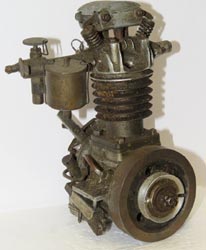 |
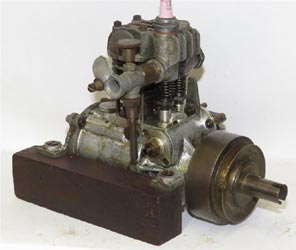 |
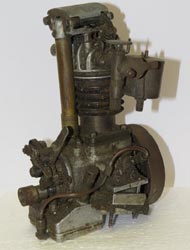 |
| Golly's much modified Kiwi | Kinglet from the ME 24" hydroplane | Drive end of Kiwi |
The original Atom 1 was, we believe, first passed to Col Bowden and then acquired by Gerry Buck and is now thought to be on the Isle of Wight. It was however the boxes full of plates, negatives and photos that have provided the greatest treasure, over 1,000 images of cars, boats and engines dating from 1927 until the 1950s, many the originals of those seen in Model Engineer, but many more never previously published, including a number featuring ETW and his hydroplanes.
The discovery of all this material and the very generous offer of copies of family and other documents provided the catalyst and information needed to produce this appreciation of Edgar Westbury’s contribution to tethered hydroplane racing in this country. It would not have been possible though without the incredible generosity of his daughter Ann and her willingness to allow us to use material from the family archive. We owe an extreme debt of gratitude to Eric Offen, who so kindly arranged for us to become involved in the first place. None of us quite knew what we were getting into and what would transpire, but it would not be wrong to describe it as a ‘unique’ experience.
All original photographs by courtesy of the Westbury family. Additional photos, Eric Offen, Tony Martin, Stuart Robinson and the late Terry Everitt.
©copyrightOTW2014